Did you know that Adidas's exit from the Russian market resulted in a loss of €250 million in revenue? Or that its advertisements have frequently faced removal in the UK due to complaints and advertising regulations?
Additionally, Adidas has successfully localized its offerings in India to tap into the cricket market, and the COVID-19 pandemic significantly boosted its e-commerce sales as consumer behaviors shifted online.
These were the outcome of external factors coming from the business environment affecting Adidas. Today's Adidas PESTLE analysis goes through all these factors in more detail.
For a global company like Adidas, conducting a PESTLE analysis is crucial because it helps the company understand the broader dynamic forces affecting its market environment.
Adidas Political Factors
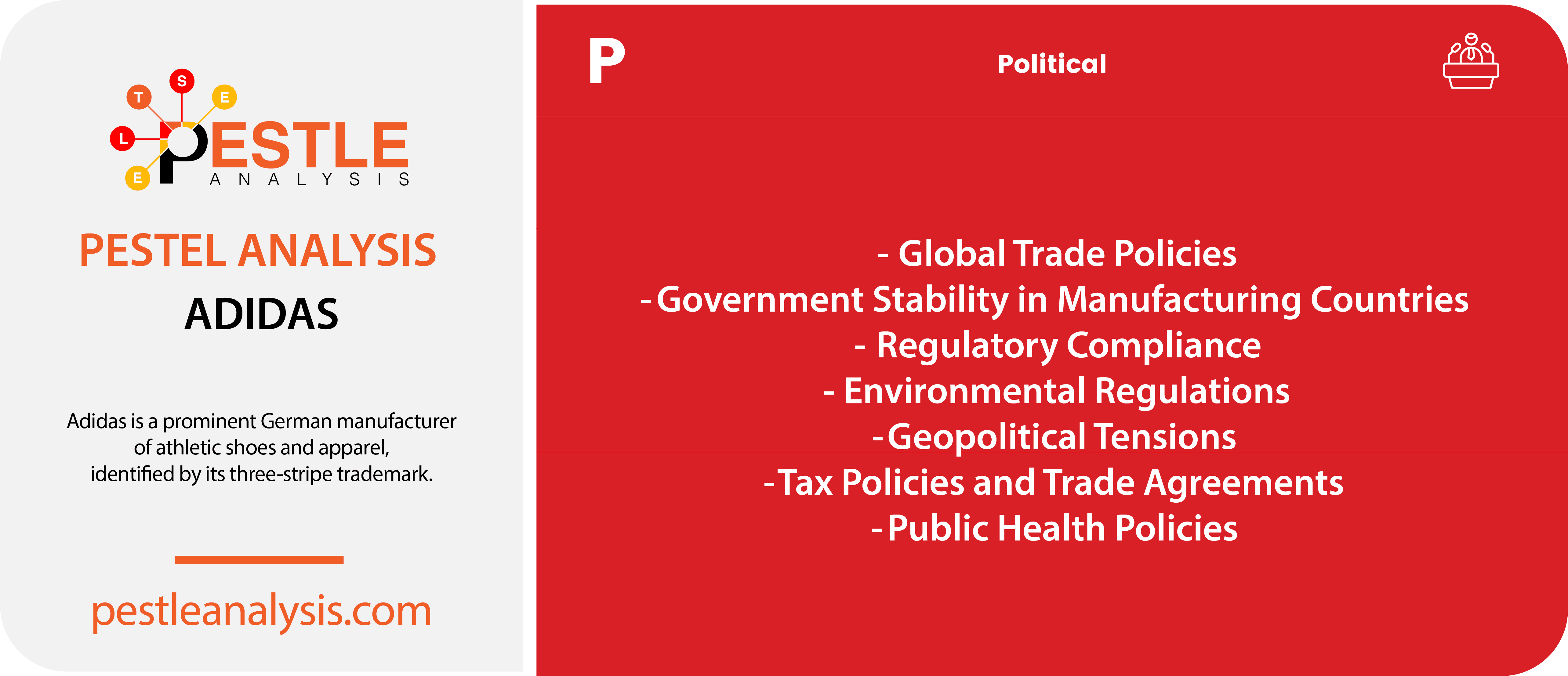
Adidas supplies, ships, and distributes their products worldwide. This requires them to extend international supply chains and follow political procedures when selling products online. Each country has its own taxation system, as well. Adidas is required to follow these rules for each sale and product distributed overseas. The company tends to outsource the development of its products to third-world countries, but communities don’t condone this type of business.
Let's go into each of the following seven political factors in more detail:
Global Trade Policies
Changes in trade policies, tariffs, and import-export regulations in key markets like the U.S., Europe, and Asia significantly affect Adidas's operations and cost structures. For example, the U.S.-China trade tensions and Brexit have led to shifts in tariff structures, affecting supply chains and pricing.
Government Stability in Manufacturing Countries
Adidas relies on manufacturing in countries like Vietnam, Indonesia, and China. Political instability, such as unrest or sudden changes in government policies, can disrupt production and affect the company’s supply chain efficiency.
Regulatory Compliance
Adidas must comply with various international regulations related to labor, production standards, and environmental laws. Changes in these regulations can influence where and how Adidas operates, requiring adaptations that could increase costs.
Environmental Regulations
Governments are increasingly implementing stricter environmental regulations. Adidas, being a significant consumer of raw materials, needs to adhere to these regulations, which may necessitate investment in more sustainable practices or materials, impacting profit margins.
Geopolitical Tensions
Political relations between countries can affect Adidas's business. For example, geopolitical tensions could limit market access or increase operational costs due to security and trade flow interruptions.
Example:
The Russia-Ukraine conflict, which escalated significantly in 2022, has had profound effects on many global businesses, including Adidas.
- Market Closure and Sales Impact:
- Like many Western companies, Adidas responded to the invasion of Ukraine by suspending its operations in Russia. Before this decision, Russia was a significant market for Adidas, contributing substantially to its sales (an estimated €250 million loss). The closure of operations in Russia means a direct loss of revenue from one of its larger markets.
- Supply Chain Disruptions:
- Although Adidas does not heavily rely on Russia or Ukraine for manufacturing, the broader regional instability can affect logistic routes and lead to increased costs. For example, increased fuel prices and disrupted logistics routes across Eastern Europe can increase transportation costs.
- Brand Reputation and Consumer Sentiment:
- Maintaining a positive brand image in the global arena often requires companies to take ethical stands. Adidas’s decision to halt business in Russia aligns with a broader corporate responsibility stance, potentially strengthening its brand image among Western consumers who favor businesses that uphold ethical values.
- Regulatory and Compliance Challenges:
- Navigating the sanctions and legal complexities introduced during such conflicts adds to the operational challenges. Adidas must ensure compliance with international sanctions and trade restrictions, which can require significant legal resources and adjustments to corporate strategies.
- Currency Fluctuations:
- Geopolitical conflicts often lead to significant currency volatility. For Adidas, this means dealing with the impacts of a weakened Russian Ruble and a fluctuating Euro, affecting their earnings and financial strategies in the region.
- Strategic Realignment:
- Long-term, Adidas may need to reconsider its strategic footprint and investment in affected regions, shifting focus to other emerging markets or strengthening its presence in stable regions to mitigate risks associated with geopolitical instabilities.
Tax Policies and Trade Agreements
Tax regulations and trade agreements between countries can affect Adidas's operations by influencing tariffs, import duties, and tax obligations in different regions. Different countries’ tax regulations, including corporate tax rates, VAT, and other tax policies, directly influence Adidas's profitability. Changes in tax laws in key markets can have significant financial implications.
Public Health Policies
Policies related to public health, such as responses to pandemics, can temporarily close stores or affect consumer behavior, as seen during the COVID-19 crisis. This impacts sales and operational capabilities.
For a complete list of political factors affecting business, check out this list.
Adidas Economic Factors
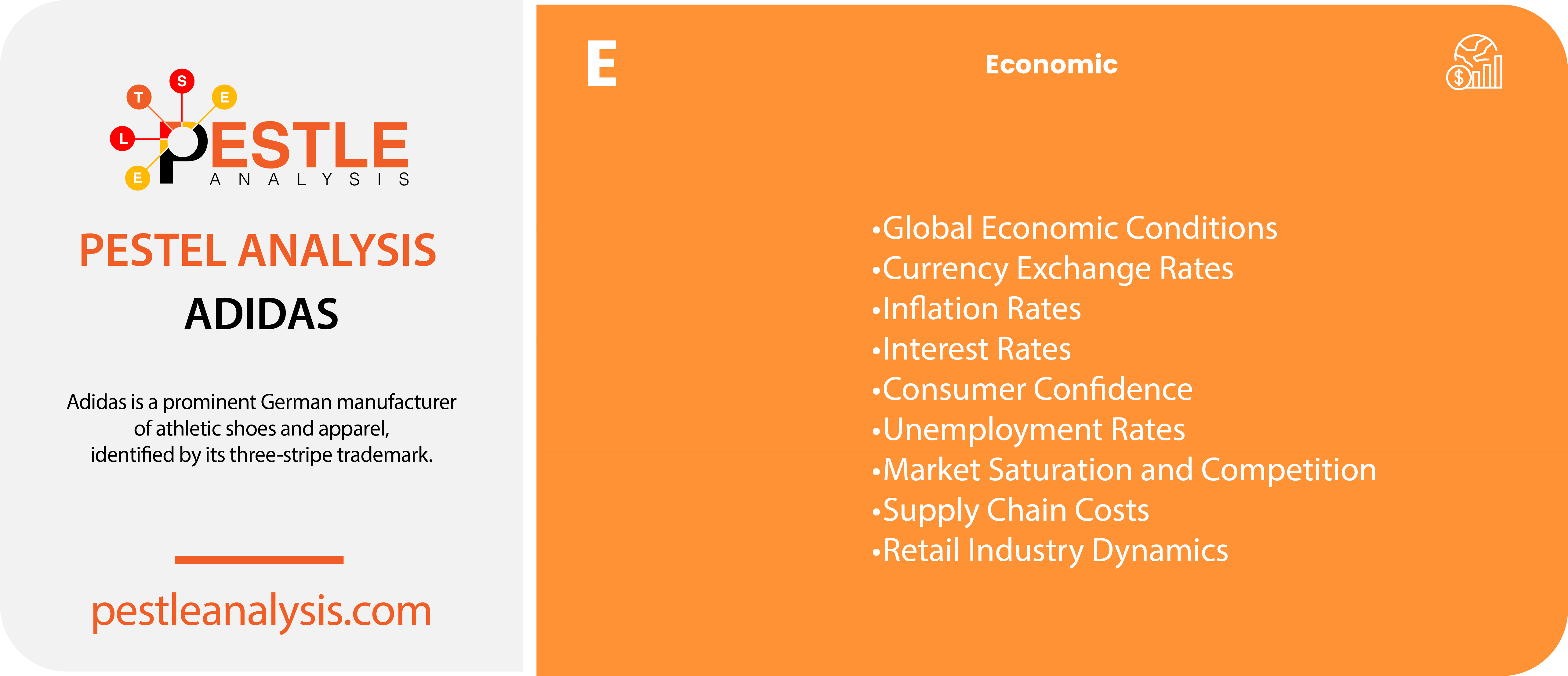
Here are nine economic factors that can significantly influence Adidas's business operations and strategic planning:
Global Economic Conditions
The overall health of the global economy affects consumer spending power. Economic downturns or recessions lead to reduced consumer spending on non-essential goods, including sports apparel and footwear.
Currency Exchange Rates
Adidas operates in multiple countries and deals in various currencies. Fluctuations in exchange rates can impact the cost of production, pricing strategies, and profit margins when converting foreign earnings back to the company’s base currency.
Inflation Rates
Inflation impacts both the cost of raw materials and labor, as well as consumer purchasing power. Higher inflation rates can lead to increased production costs and reduced consumer spending.
Interest Rates
Changes in interest rates affect Adidas’s cost of capital and financing options. Lower interest rates make borrowing cheaper, potentially facilitating expansion and investment. Conversely, higher rates increase costs and can slow down investment.
Consumer Confidence
The level of consumer confidence directly influences spending behavior. Higher confidence levels generally lead to increased spending on discretionary items like sportswear and athletic equipment.
Examples:
- During the COVID-19 Pandemic (2020-2021): Consumer confidence plummeted due to uncertainty about health, job security, and the economy. This period saw a significant decline in retail sales initially. However, Adidas noted a surge in online sales as consumers shifted their shopping habits, partially offsetting the decline in physical store sales. According to Adidas’s 2020 Annual Report, their e-commerce sales increased by 53% in 2020, indicating a shift in consumer behavior despite lower overall confidence.
- Post-Pandemic Recovery (2021-Onwards): As economies began to recover and consumer confidence started improving, Adidas saw a rebound in sales. The lifting of lockdowns and a gradual return to normalcy helped restore consumer confidence, which translated into increased spending on sports and lifestyle products. Adidas reported a strong recovery with overall sales growth, particularly notable in markets that were reopening and stabilizing economically.
Unemployment Rates
Higher unemployment rates typically lead to a decrease in disposable income and spending power, which can negatively affect sales of consumer goods companies like Adidas.
Market Saturation and Competition
The degree of market saturation and the intensity of competition in key markets affect pricing, market share, and profitability. Adidas faces stiff competition from other major players like Nike, Puma, and Under Armour.
Supply Chain Costs
The cost associated with logistics and supply chain management, influenced by fuel prices, labor costs, and transportation tariffs, significantly affects Adidas's operational efficiency and overall expenses.
Retail Industry Dynamics
The health and economic growth of the retail sector, including the shift towards online shopping and the performance of major distributors and retail partners, impacts Adidas's sales channels and revenue streams.
Example of economic factors affecting Adidas: For a company like Adidas, fluctuations in consumer confidence can significantly impact sales.
Here's a complete list of economic factors affecting any business.
Adidas Social Factors

Adidas changes designs of their products. Designs match the interest of consumers. Products are often available for any age, gender or lifestyle. But their core focus group are health-conscious buyers with a love for sports. They must keep up with health trends and preferences to cater to their audience.
They also offer corporate volunteer programs. They support communities and foster the health of individuals. Adidas also supports the Olympics, which allows them to leverage marketing opportunities and catch the eye of new audiences around the world.
Social factors are crucial in shaping the market dynamics and consumer preferences that influence Adidas's business strategies. Here are nine key social factors impacting Adidas:
Changing Consumer Preferences
Consumers are increasingly looking for products that are not only functional but also fashionable. This trend requires Adidas to continuously innovate and align their product designs with current fashion trends.
Health and Wellness Trends
The growing global emphasis on health and wellness has led to increased participation in sports and fitness activities. This shift boosts demand for sportswear and equipment, benefiting Adidas.
Sustainability and Ethical Production
There is a rising demand for sustainable and ethically produced goods. Consumers are more aware and concerned about the environmental impact of their purchases, pushing Adidas to invest in sustainable materials and production methods.
Globalization of Consumer Culture
As global media and communication improve, consumer culture becomes more homogeneous. Adidas must cater to a global market while also localizing products to fit regional tastes and preferences.
Example:
Adidas has consistently showcased its ability to adapt and create localized products that cater to specific regional tastes and cultural preferences, which is a crucial aspect of its global strategy. One notable example of this approach is their creation of cricket shoes and apparel specifically designed for the Indian market.
This example demonstrates how Adidas's strategic focus on localization—by understanding and integrating into the cultural fabric of a particular region—can lead to successful product launches that resonate with local consumers and meet distinct regional demands.
- Cricket is immensely popular in India, a country with a burgeoning population and a growing middle class with increasing disposable income. Recognizing the sport's cultural significance and widespread appeal in India, Adidas developed specialized cricket shoes and apparel tailored to the needs and preferences of Indian consumers.
- The strategy involved not only product development but also targeted marketing campaigns featuring local cricket icons and promotions aligned with major cricket events in India, such as the Indian Premier League (IPL).
- Adidas launched cricket shoes designed with specific features like enhanced grip and flexibility to suit the playing conditions commonly found on cricket fields in India. Additionally, the apparel was adapted to suit the local climate and included features like advanced moisture-wicking fabrics to enhance comfort during long hours of play in typically hot and humid conditions.
- This localized approach allowed Adidas to tap into a significant market segment in India, enhancing its brand presence and sales in the region. By addressing the specific needs and preferences of Indian cricket enthusiasts, Adidas strengthened its position as a serious contender in the sportswear market in India, competing effectively with other global and local brands.
Demographic Changes
Changes in global demographics, such as aging populations in developed countries or younger demographics in emerging markets, affect product demand and marketing strategies.
Urbanization
Increasing urbanization leads to lifestyle changes that influence consumer behavior and preferences, including a higher demand for versatile, urban-appropriate sportswear.
Social Media Influence
Social media platforms significantly influence fashion and lifestyle trends. Adidas leverages influencers and campaigns on these platforms to enhance brand visibility and engagement, tapping into the fan bases of these personalities.
Income Distribution
Economic inequality affects market segments Adidas can target effectively. The brand needs strategies for both premium products and more accessible items to cater to diverse economic backgrounds.
Leisure Time
The amount of leisure time consumers have can impact their participation in sports and recreational activities, thereby influencing demand for Adidas products.
For a complete list of social factors affecting business, check out this list.
Adidas Technological Factors
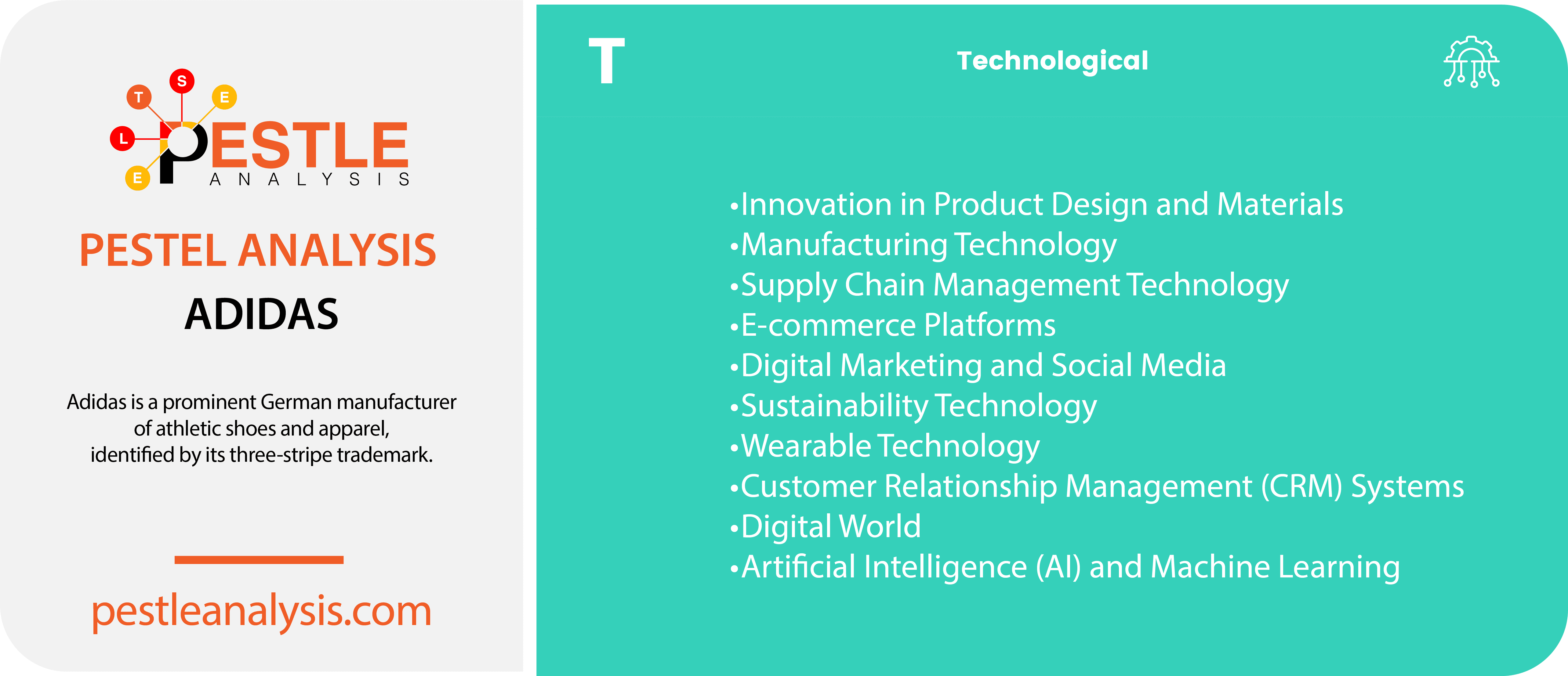
Adidas tests its products under varying conditions. It’s because they cater to athletes. They are trying to optimize performance for coaches and professionals in the sports industry. For durable solutions to athletic problems, they use natural material replacements. They support online sales through their website and social media. Now, they’re studying the smart sportswear industry. Technology, like the Fitbit, is quite popular in the health communities. Adidas can use these technological advancements to dive into new industries and develop an edge over the competition.
Technological factors play a critical role in shaping the strategic decisions and operational efficiency of Adidas. Here are ten key technological factors that influence the company:
Innovation in Product Design and Materials
New product design techniques and materials come up every year. By investing heavily in research and development, Adidas can innovate its product designs, such as using advanced materials like recycled plastics or developing lighter, more durable footwear. This not only enhances performance but also appeals to environmentally conscious consumers.
Manufacturing Technology
The adoption of advanced manufacturing technologies, such as automation and 3D printing, will help Adidas reduce costs, increase production speed, and enhance customization options for consumers.
Supply Chain Management Technology
Technologies like RFID (radio-frequency identification) and AI-driven logistics platforms will enable Adidas to optimize its supply chain operations, improving inventory management and reducing lead times.
E-commerce Platforms
As e-commerce platforms become more advanced, Adidas must invest in robust e-commerce platforms, especially as online sales continue to grow. Enhancing the digital shopping experience through technology improves customer satisfaction and drives sales.
Digital Marketing and Social Media
Leveraging new digital marketing tools and social media platforms will enable Adidas to engage directly with consumers, promote new products, and build brand loyalty. Technologies that analyze consumer behavior also allow for more targeted marketing strategies.
Sustainability Technology
As sustainability becomes increasingly important, Adidas can utilize new technologies to reduce waste and environmental impact. This includes innovations in sustainable materials and eco-friendly manufacturing processes.
Wearable Technology
The integration of technology into apparel and footwear, such as smart shoes that track performance metrics, is a growing trend that Adidas is exploring to enhance the functionality of its products.
Customer Relationship Management (CRM) Systems
Fresh advanced CRM systems help Adidas understand and respond to customer needs more effectively, tailoring communications and offerings to enhance customer relations and retention.
Digital World
With the increase in digital transactions, Adidas must ensure strong cybersecurity measures to protect customer data and prevent breaches, maintaining trust and compliance with data protection regulations.
Example:
Since 2023, one notable technological factor that has significantly impacted Adidas is the advancement in digital and direct-to-consumer platforms, particularly in enhancing its e-commerce capabilities. Here's our PESTLE analysis of the e-commerce industry, by the way.
- Adidas has invested in its online platforms to provide a more seamless and personalized shopping experience. This includes the integration of advanced analytics and AI to understand consumer preferences and behavior, which allows Adidas to offer personalized product recommendations and more tailored marketing communications.
- The company has also enhanced its mobile app capabilities, which not only improve the shopping experience but also integrate loyalty programs and exclusive releases, further driving online sales and customer engagement.
Artificial Intelligence (AI) and Machine Learning
AI and machine learning are increasingly used for everything from demand forecasting and price optimization to personalized customer experiences, enabling Adidas to stay competitive in a rapidly changing market.
For a complete list of technological factors affecting business, visit this page.
Adidas Legal Factors
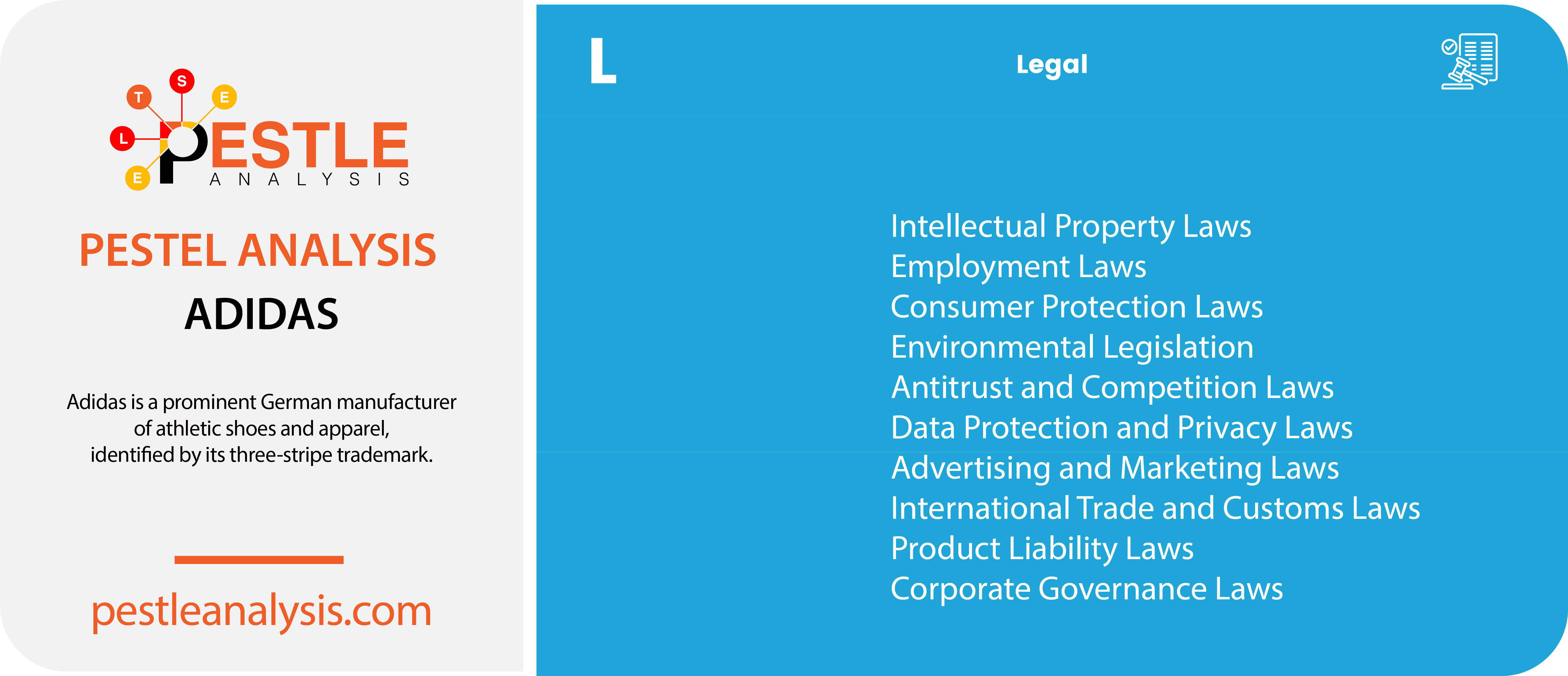
Adidas has ownership of intellectual properties and IP systems. They also have design patents, defending their right against copiers and infringement. The patents also serve as legal protection to end counterfeit businesses. As a big company, they naturally have trademark production.
Because if their connection to the sports world, Adidas endorses celebrity sponsorships as a form of marketing. And follow full compliance with national and local laws.
Legal factors play a significant role in shaping the operations and strategic decisions of multinational corporations like Adidas. Here’s an exploration of ten legal considerations that Adidas must take into account:
Intellectual Property Laws
Adidas heavily invests in innovation, design, and branding, making the protection of its intellectual property crucial. This includes patents for technology, trademarks for brand elements, and copyrights for design and marketing materials. Compliance with international intellectual property laws is essential to safeguard its assets and prevent counterfeiting.
Employment Laws
As a global employer, Adidas must adhere to diverse employment regulations in the countries where it operates. These laws cover a wide range of issues including wages, employee benefits, working conditions, and anti-discrimination measures. Ensuring compliance helps avoid legal disputes and enhances the company’s reputation as a fair employer.
Consumer Protection Laws
Adidas is subject to consumer protection regulations that ensure the safety and quality of its products. These laws mandate that Adidas meets certain standards in product design, manufacturing, and marketing to protect consumers from harm and misleading claims.
Environmental Legislation
Environmental laws affect how Adidas sources materials and manages its production processes. These include regulations on waste disposal, emissions, and the use of toxic substances. Adidas has increasingly focused on sustainability, aligning its operations with legal standards and consumer expectations for environmental stewardship.
Antitrust and Competition Laws
In various jurisdictions, Adidas must comply with antitrust laws designed to prevent anti-competitive practices. These laws ensure that Adidas engages in fair competition regarding pricing, production, and market entry.
Data Protection and Privacy Laws
With a significant portion of its business conducted online, Adidas must comply with data protection and privacy laws such as the General Data Protection Regulation (GDPR) in the European Union. These regulations govern how Adidas collects, stores, and uses consumer data, requiring robust cybersecurity measures and transparent data practices.
Advertising and Marketing Laws
Legal standards governing advertising ensure that Adidas’s marketing strategies are not misleading or deceptive. Compliance is critical to maintain consumer trust and avoid legal penalties.
Example:
The UK’s Advertising Standards Authority (ASA), which regulates advertising across various media, challenged Adidas on the content of an advertisement for their "Predator" football boots in 2015. More recently, ASA banned Adidas ads in the UK for ‘explicit nudity’ in 2022.
- The Advertisement: Adidas released an advertisement that claimed their "Predator" boots would offer players “100% legal”, “0% fair” advantages, and prominently featured the statement “#ThereWillBeHaters”. The advert implied that the boots could provide significant enhancements to a player’s performance.
- The Challenge: The ASA received complaints regarding the advertisement’s claims. The primary issue was whether the slogans used in the advertisement exaggerated the effect of the football boots and could be misleading to consumers, potentially violating advertising standards that demand honesty and substantiation of claims.
- The Outcome: After reviewing the case, the ASA ruled that the advertisement was indeed misleading. The authority determined that Adidas’s claims could not be substantiated sufficiently — that the boots provided performance enhancements to the degree implied by the slogans. Adidas was instructed to remove the advertisements or alter them to comply with UK advertising laws.
International Trade and Customs Laws
Adidas must navigate a complex web of international trade laws, including customs regulations and import/export restrictions. Compliance is crucial for the smooth operation of its global supply chain and to avoid legal and financial penalties.
Product Liability Laws
Adidas is responsible for ensuring its products do not pose a risk to consumers. Adherence to product liability laws is essential to prevent lawsuits and the associated financial and reputational damage.
Corporate Governance Laws
As a publicly traded company, Adidas must follow strict corporate governance regulations. These laws mandate transparency, fairness, and accountability in the company’s operations to protect the interests of shareholders and other stakeholders.
Here's a complete list of legal factors affecting any business.
Adidas Environmental Factors
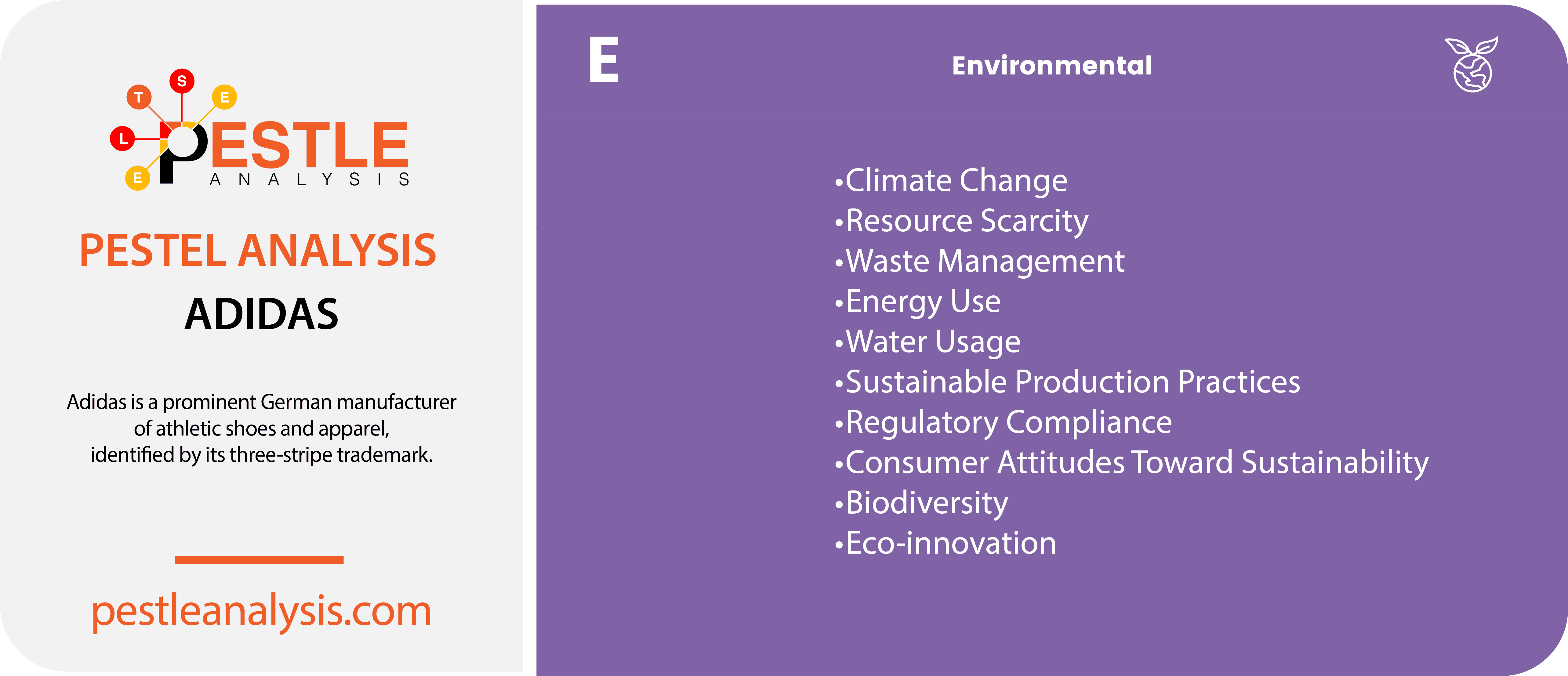
Adidas decreases environmental impact. It’s their duty to monitor hazardous substances and eliminate them. This may be why they offer natural materials in their products. They follow ethical business practices by committing to ensure supplies are following regulations in every country their products are manufactured in.
Here’s a detailed look at ten environmental factors that influence Adidas:
Climate Change
The impact of climate change affects Adidas both in terms of operational logistics and material sourcing. Extreme weather conditions can disrupt supply chains and affect the availability of natural resources used in their products.
Resource Scarcity
Adidas relies on various raw materials like cotton, rubber, and leather. Scarcity of these materials, driven by overconsumption and environmental degradation, can lead to increased costs and push the company towards more sustainable materials.
Waste Management
The disposal of waste materials from product manufacturing and post-consumer waste are significant concerns. Adidas has initiated efforts to use recyclable materials and promote the circular economy to address waste issues.
Energy Use
The need for reducing carbon footprint compels Adidas to invest in energy-efficient technologies and renewable energy sources for their manufacturing and retail operations.
Water Usage
Water is a critical resource in the manufacturing of many Adidas products, especially in the dyeing of fabrics. The company faces the challenge of minimizing water usage and ensuring that wastewater discharge complies with environmental standards to reduce pollution.
Example:
Adidas has actively pursued strategies to reduce water use and energy consumption as part of its broader commitment to sustainability. A notable example of their efforts in real life is the implementation of the "DryDye" technology which significantly reduces water usage in the dyeing process.
- In 2012, Adidas introduced DryDye technology, which uses pressurized carbon dioxide (CO2) instead of water to dye textiles. This technology not only eliminates the need for water in the dyeing phase but also reduces the amount of energy used by about 50% compared to conventional methods.
- Adidas initially used this technology to dye 50,000 t-shirts, saving approximately 1,250,000 liters of water—illustrating the potential for significant environmental impact. Following the success of this initial project, Adidas expanded the use of DryDye technology across more products and collections.
Sustainable Production Practices
There is growing pressure on Adidas from consumers and regulatory bodies to adopt more environmentally friendly production practices. This includes reducing chemical use, lowering greenhouse gas emissions, and using sustainable materials.
Regulatory Compliance
Adidas must adhere to a wide range of environmental regulations across different countries, including laws related to emissions, pollution, product packaging, and recycling. Compliance is crucial to avoid legal penalties and reputational damage.
Consumer Attitudes Toward Sustainability
Consumer demand for sustainable products is growing. Adidas responds by integrating eco-friendly practices into their product design and marketing, which helps to strengthen their brand loyalty and attract environmentally conscious consumers.
Biodiversity
Operations that impact local ecosystems can lead to biodiversity loss. Adidas is responsible for ensuring that their material sourcing and manufacturing practices do not adversely affect the surrounding environment.
Eco-innovation
Innovating new products that minimize environmental impact is crucial. Adidas has been a leader in this area with initiatives like using recycled plastics from ocean waste to create shoes and apparel.
For a complete list of environmental factors affecting business, check out this post.
More Research on Adidas PESTLE Analysis
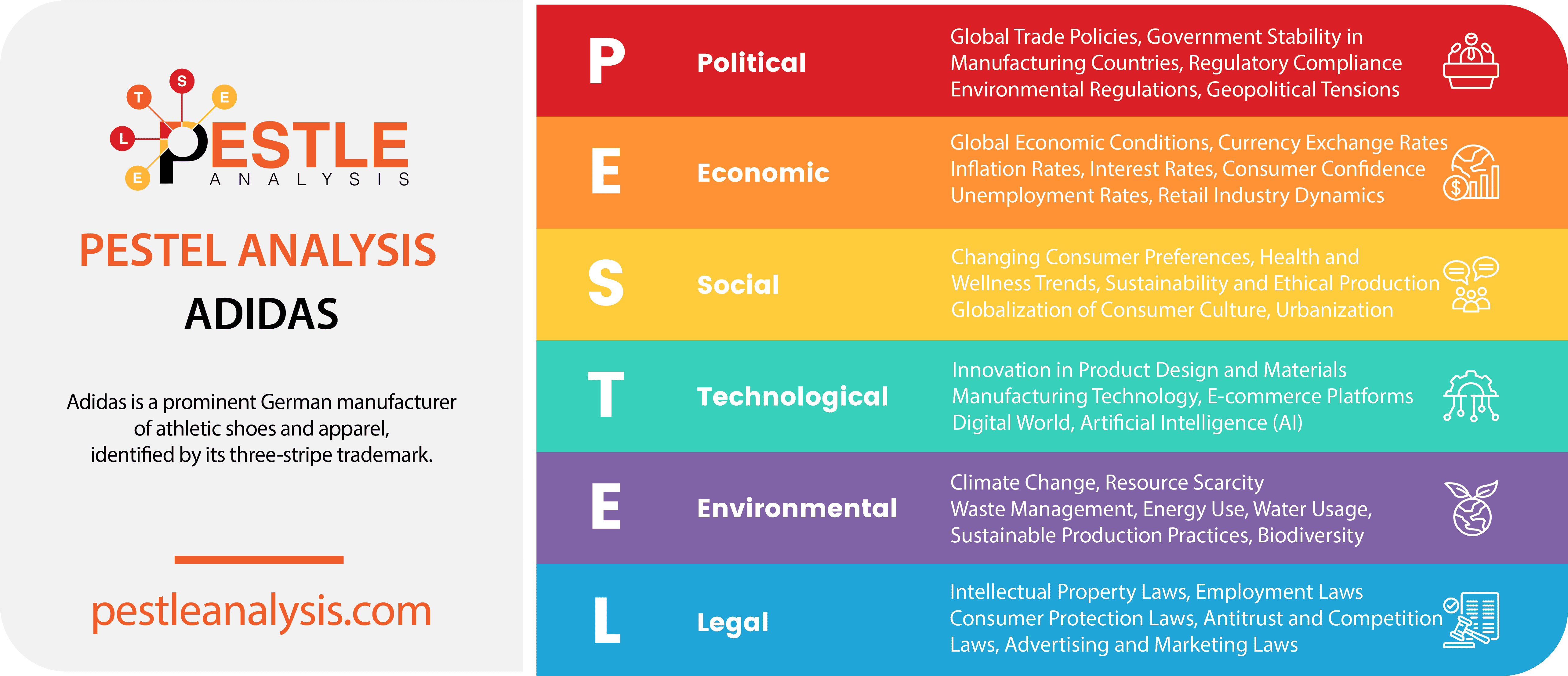
That concludes our PESTLE analysis of Adidas, providing a comprehensive overview of the external factors influencing this global sports apparel giant. This strategic tool has dissected the Political, Economic, Social, Technological, Legal, and Environmental external factors crucial for understanding Adidas's business environment. Today's PESTLE analysis complements our recent SWOT analysis of Adidas.
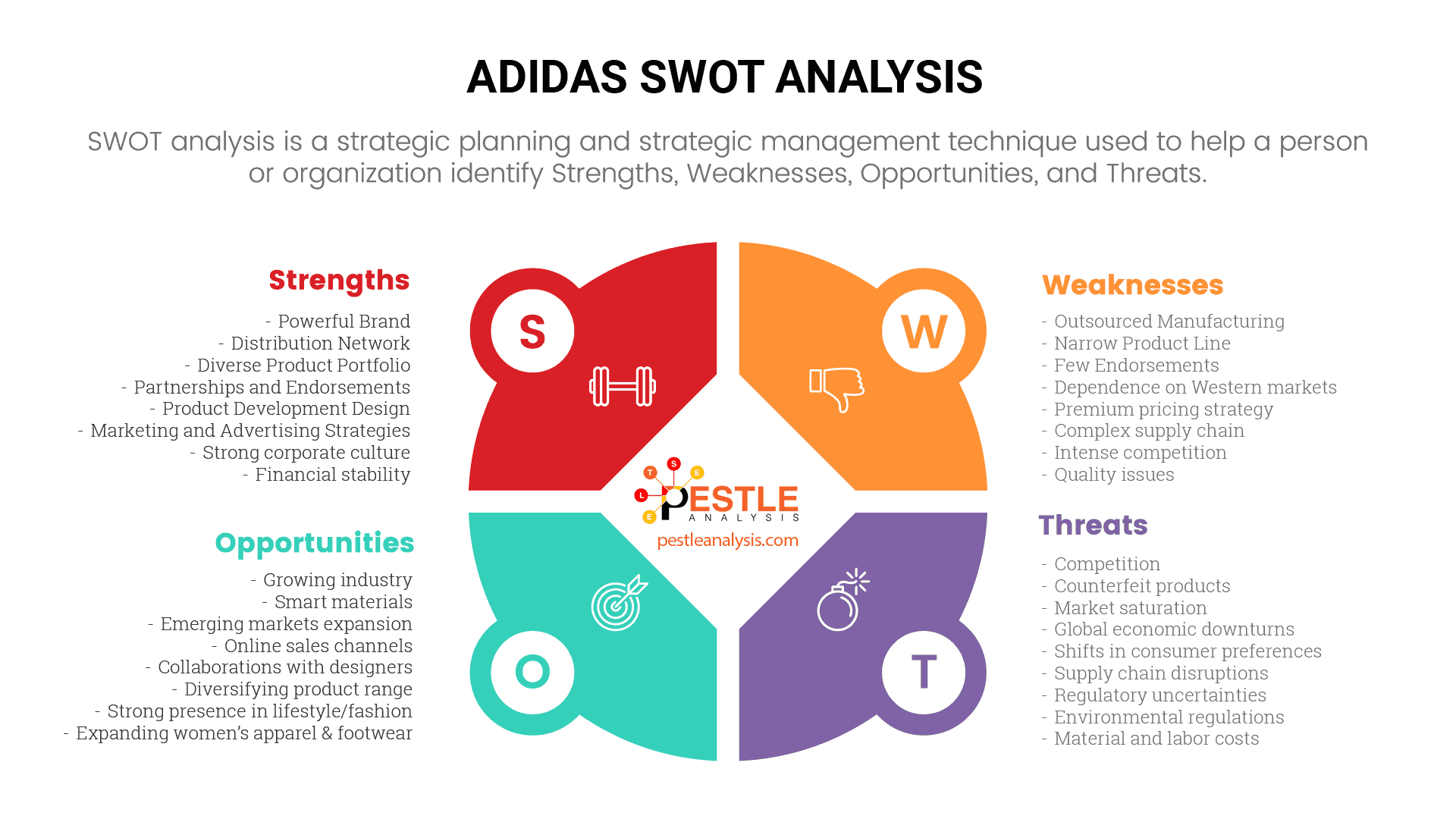
For further insights into the competitive dynamics of the athletic wear industry, check out some of the analysis we've done on Adidas’s key competitors here at PESTLEanalysis. This will equip you with a broader understanding of the market and the different strategic positions of leading players in the field.
- PESTLE analysis of Nike
- PESTLE analysis of Puma
- PESTLE analysis of Under Armour
- PESTLE Analysis of Ralph Lauren
- PESTLE analysis of the sportswear industry








